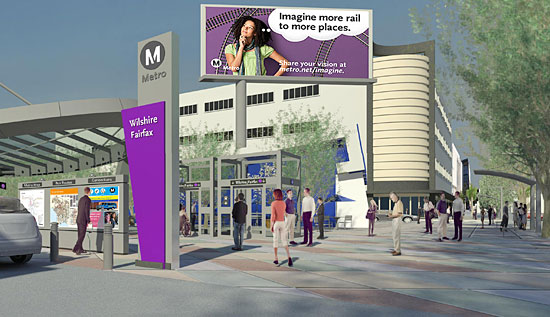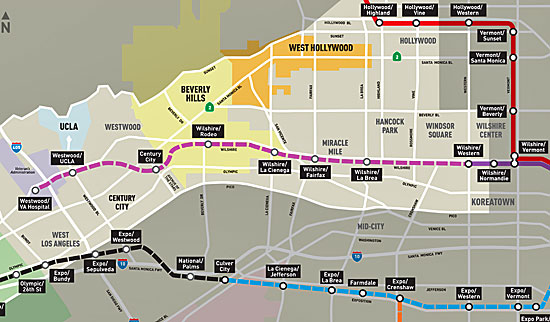Subway makes tracks toward Westwood
March 23, 2012

The subway's 7 proposed stations, most along Wilshire, could look something like this, at Fairfax near LACMA.
Metro officials today unveiled final environmental documents for the Westside Subway, detailing a 9-mile extension of the existing Purple Line subway with seven recommended stops, including a Century City station at Constellation Boulevard and Avenue of the Stars—a location approved by a panel of top scientists but hotly contested by some officials in Beverly Hills.
The release of the final environmental reports marks a significant milestone for the project, which has been in the planning stages for more than four years. When completed, the subway is expected to log 78,000 trips a day and make it possible to travel from downtown L.A. to Westwood in 25 minutes.
While the project will benefit riders throughout the region, its impact will be felt most strongly on the Westside, which has a heavy concentration of jobs along with some of the worst traffic in the nation.
“This is a project that Los Angeles has been talking about for at least a half a century,” said Jody Litvak, Metro regional communications manager. She called the release of final environmental documents “a huge accomplishment” and a “delivery to voters on the promises of Measure R,” the ½-cent sales tax that will partially fund the subway.
The Westside Subway would begin where the Purple Line currently ends, at Wilshire and Western. The new stations would be located along Wilshire at La Brea, Fairfax, La Cienega and Rodeo Drive, as well as in Century City, at UCLA and at the V.A. Hospital.
The siting of the Century City station has been controversial. Because the route to get to the proposed Constellation station would pass under the Beverly Hills High School campus, some city officials have raised safety concerns about tunneling in the area and urged that the Century City station be built instead under Santa Monica Boulevard.
But last year, a panel of high-profile scientific experts convened by Metro said that active earthquake faults make the Santa Monica Boulevard location too dangerous for a subway station. These experts, including Lucy Jones of the U.S. Geological Survey and Caltech, found instead that a station could be safely built at the Constellation site, which has no evidence of active faults. In addition, they said that tunneling under the high school property could be accomplished safely with state-of-the-art equipment and techniques even through earthquake zones and ground with large concentrations of methane gas.
Beverly Hills hired experts of its own to review Metro’s scientific conclusions. Those experts argue that more research is needed, particularly around the Constellation site and on the high school campus. (The city’s website has links to those reports, as well as other information on Beverly Hills’ position on the subway.) In addition, the Beverly Hills school board recently commissioned widespread trenching studies on the high school campus to determine whether seismic hazards are present; a report on that is expected soon.
Metro officials say the final environmental documents released today make it clear that it will be safe to build a subway station at Constellation, but said they will be studying the Beverly Hills reports carefully. (Updated: The Beverly Hills School District’s attorney, Kevin Brogan, issued a statement criticizing Metro for releasing the final environmental documents before receiving the results of the trenching studies. His statement is here.)
Agency officials said the Constellation station also would attract more riders and be closer to more jobs than the Santa Monica Boulevard station. The agency projects 8,600 boardings at Constellation each weekday, compared to 5,500 boardings at Santa Monica Boulevard.
The final environmental reports also studied various alternatives for the two stations in Westwood. For the UCLA station, the report recommends a location on Wilshire at Westwood Boulevard. At the V.A. Hospital, it recommends building the station on the south side of Wilshire at Bonsall Avenue, in the northern edge of the hospital’s parking lot just west of the 405 Freeway.
Plans call for the subway to get to Wilshire and La Cienega by 2020, to Century City by 2026 and to the Westwood V.A. Hospital by 2036. However, some officials, including Metro Board Chair and Los Angeles Mayor Antonio Villaraigosa, are pressing for the entire project to be completed much sooner—by 2022—under an accelerated building program known as America Fast Forward.
Metro has estimated the cost of the project at $5.66 billion in 2022 dollars, but that could rise to an estimated $6.29 billion if the project takes until 2036 to complete. Some funding will come from Measure R but more will be needed from the federal government’s “New Starts” program.
The final environmental documents are scheduled to go before Metro’s Board of Directors on April 26. If the board votes to certify the project, the Federal Transit Administration will be asked to sign off on the plans and formally conclude the federal environmental review phase of the project. Then, final design work is expected to take about a year, with groundbreaking slated for sometime in 2013.
A series of informal community open houses are scheduled next week so that people can learn more about the project and see artists’ renderings of what some of the stations could look like. They will be held on Monday, March 26, at the Los Angeles County Museum of Art; on Wednesday, March 28, at Westwood United Methodist Church; and on Thursday, March 29, at Temple Emanuel in Beverly Hills. Each of the meetings will run from 5 p.m. to 7:30 p.m. Additional details and parking information are here.

The 9-mile extension of the Purple Line starts at Wilshire and Western and ends at the VA Hospital in Westwood.
Posted 3/19/12












 405 bridge work causes a stink
405 bridge work causes a stink

